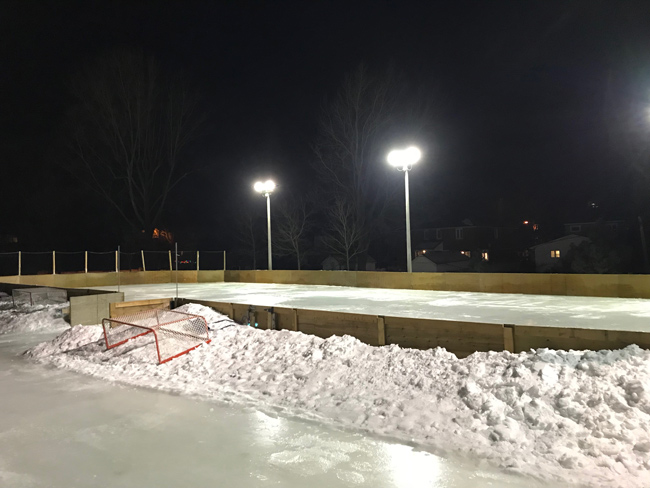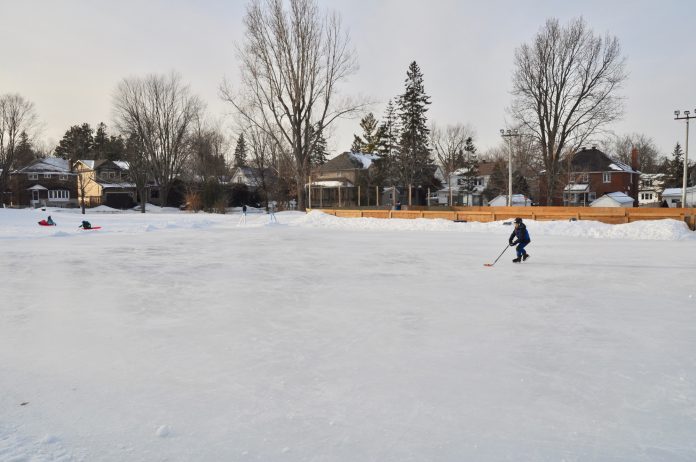By Andrea Tomkins –
I made a swishing sound as I walked to Dovercourt Recreation Centre. I wore the warmest clothing I owned, including a thick pair of ski pants, a long down-filled puffy coat with the hood drawn up, and four layers of clothing underneath it, not to mention wool ski socks, winter boots, and thick gloves.
It was a beautiful night; as clear and dark as they come here in Westboro. It was 9 p.m., and quiet, -16C, and no wind. By all accounts, it was the best kind of night to flood the rink.
I recently met Stewart Dewar, an area resident and one of the volunteers who maintain the ice at Westboro Kiwanis Park, which is the name of the park behind Dovercourt. He’s also the “keeper of the list,” meaning he’s the one who watches the weather, recruits volunteers, and decides when and if the ice needs flooding. It was during our chat for an article in the recent issue of KT that I decided I would come along one night and see the process up close and experience it for myself.
It was just after nine when I arrived at the Dovercourt trailer, which serves as a warm-up hut during the skating season and also houses the giant hose that’s used to flood the ice. Stewart introduced me to the newest volunteer on the roster, Skylar Michaels, and we went to work. There are two parts to the rink maintenance routine: shoveling and scraping, followed by flooding. I counted myself lucky that the shoveling part was already done when I arrived, but it was clear that it’s an enormous part of the job. Too much snow on the ice, not to mention ice chunks, would affect our goal: a smooth sheet of ice for skating.
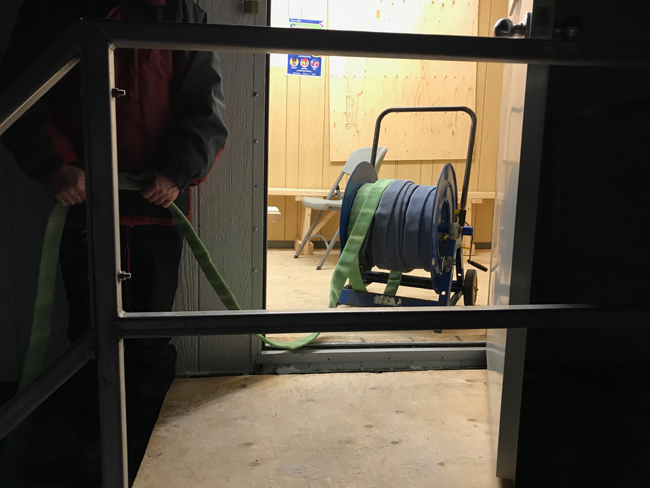

The first step is to unspool the hose. This may be obvious to some, but this is not your garden variety watering device. I’m guessing it’s a lighter weight fireman’s hose. It’s several inches wide and made out of a thick canvas-type material that looks virtually indestructible. Stewart estimates it’s about 200’ long. Once it’s connected and has water running through it, it’s heavy.
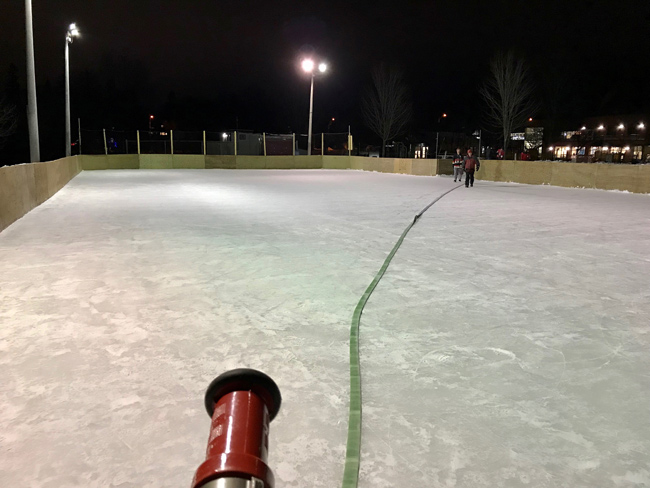
My first task: to drag the hose to the far corner of the enclosed rink. Here’s where I should point out that Dovercourt has two skating surfaces: the rink, which is enclosed by tall boards and is intended for hockey games, and what’s commonly referred to as a “puddle,” an open area between the rink and the small sledding hill. Stewart and I chatted about the choice of the word “puddle” to describe the second skating area and he told me he prefers the word “pond” because it’s a bit more upscale. This is not a mere puddle! (I don’t disagree.)
The hose was turned on and the flooding part of the evening officially began.
Stewart showed me the ropes and gave me a chance to flood as well. A successful flood, said Stewart, is all in the prep. “It’s just like painting.” [Click the image below for the “hose cam” perspective.]
https://www.instagram.com/p/BebAXABloYK/?taken-by=quietfish
Pointing a stream of water at the ground seems like a relatively simple idea, and it is, but I was wary that my inexperience would ruin someone’s game of pick-up the next day. Accumulated piles of snow at the base of the boards had to be pulverized by a concentrated jet of water to get rid of them (“otherwise the puck flips up during a game”) and otherwise it’s a matter of covering the rest of the ice with a good layer of water. Some folks choose the “side to side” motion of hosing while others just let it flow. It’s a matter of personal preference. The question of how much water is a tough one to answer, and rather unscientific. “Until it starts to flow away,” said Stewart. The idea is for the water to fill the cracks in the ice and create a smooth solid layer so the answer to the “how much water” question varies depending upon the weather, whether the ice was heavily used, and if it had been flooded recently.
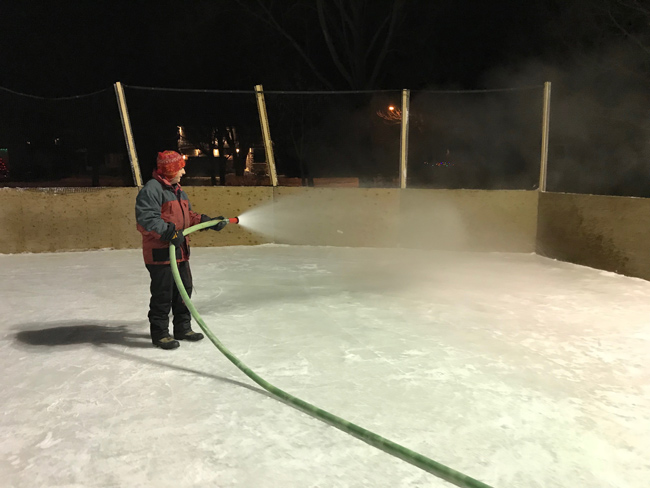
No word of a lie: I enjoyed my turn with the hose. Stewart told me that it’s a very peaceful task, and it is. The spray of the water makes a gentle sound and you tend to get lost in your thoughts as you watch it hit the ice and flow this way and that. While I watered the ice, Stewart and Skyler were the “hose support” crew, making sure the hose was straight and out of my way as I systematically covered the ice with water. Like a garden hose, a kink in the hose impedes water flow, but because it’s so heavy it’s not easy for the person holding the hose to straighten it out again.
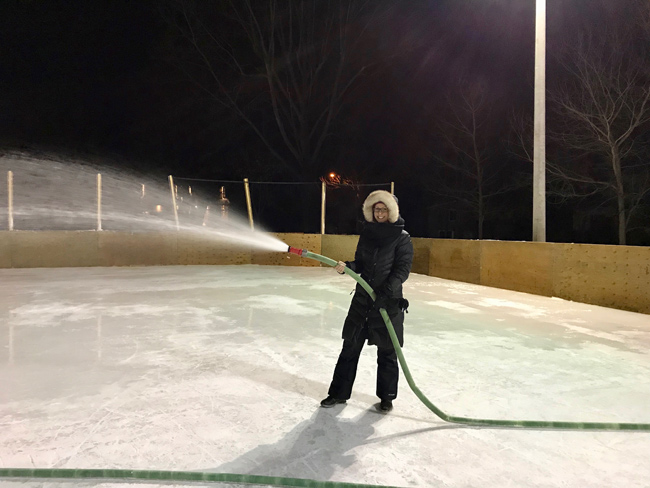
I did most of the enclosed rink before handing the hose back to Stewart. My arms were starting to ache but I don’t know if it was from the weight of the hose or a result of the yoga class I’d finished earlier that evening. Amazingly, I didn’t spray myself – or anyone else for that matter – and I think I did an ok job (at least Stewart said as much although to be fair I wasn’t sure if he was just being polite).
Stewart flooded the pond himself. The three of us chatted about all kinds of things – Westboro development, the future of the news business, municipal politics – and I realized that although the task of flooding is work, it’s also very social. The time goes by quickly, even quicker when there are more people on hand to share the work! It is also rewarding. I felt good knowing that the hour or so we spent out there means there’s a place for kids to gather for some outdoor fun after school. It means people of all ages can gather and play hockey. Maybe a new neighbour will learn how to skate in a relaxed environment. My kids are grown up now, but they learned to skate here. It’s good to pay it forward.
The last part of the evening was probably the hardest for me, as a newbie. The hose, which is comprised of several segments, is disconnected and disassembled so each part can be drained and put back on the reel. This is where wet mitts happen! My task was a small one. I disconnected each segment and stretched them out so they were straight and flat, at which point Stewart or Skylar would take it and string it up on a tree branch to drain the water from it. Each segment is then brought back to the trailer and wound back on to the spool.
Soon it was time to go home; good timing too, because my toes were starting to get cold. The front of my scarf was frozen; otherwise, I was in good shape. We all parted ways and wished each other a good night. Happily swishing home again, I thought how fortunate we are to have an outdoor skating rink in our community, and most importantly, that are people who are willing to put in the effort to maintain it.
